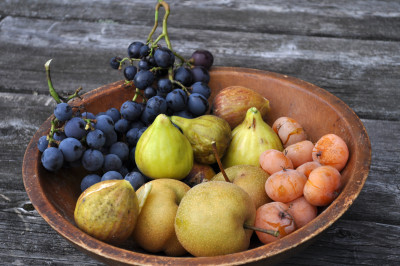UPCOMING EVENTS
/1 Comment/in Gardening/by Lee ReichGRAFTING WORKSHOP, APRIL 9, 2016, Springtown Farmden, New Paltz, NY, www.leereich.com/workshops
LECTURE: LUSCIOUS LANDSCAPING, WITH FRUITS, APRIL 16, 2016, Hamilton College Arboretum, Clinton, NY
PRUNING WORKSHOP, MAY 6-8, 2016, Omega Institute, Rhinebeck, NY
DRIP IRRIGATION WORKSHOP, MAY 14, 2016, Phillies Bridge Farm Project, New Palts, NY, register at www.leereich.com/workshops
PLANT SALE, MAY 21, 2016, Springtown Farmden, New Paltz, NY, 9:30-11:59 am
And a final note to anyone who has subscribed to my blog: A gremliin may have entered the system and messed with the subscriptions. So if you’re not getting blog post notifications but want them, either re-subscribe or else unsubscribe and then re-subscribe.
THE WEATHER CALLS THE SHOTS
/0 Comments/in Fruit, Gardening, Planning, Pruning, Vegetables/by Lee ReichThe Kindest Cuts
In years past, when I went outdoors this time of year, it was usually with skis strapped to my feet. Or wearing snow boots. Or snowshoes. With this snowless, warm winter, I’m mostly going outdoors these days armed with pruning shears, a lopper, and a pruning saw. Mostly, my feet trod a path to the hardy kiwifruit vines and the blueberry bushes.
At first glance, the blueberries seem nothing more than a jumbled mass of stems of various ages. How to make order out of this jumble? Quicker to answer is why go to the trouble of making order out of this jumble. The same could be asked for my lilac bush, mockorange, hazelnuts, gooseberries, and currants.
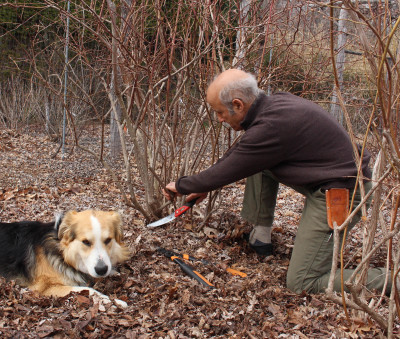
Sammy & me, pruning blueberries
Then I remind myself that my goal is to reduce the crop — yes! reduce the potential crop — so that more of the each fruit or nut bush’s resources get channeled into fewer fruits or nuts so those that remain taste better. I also prune for future years’ harvests or, for flowering bushes, future years’ flowers. And I prune to let the stems of all bushes bathe in light and air, which reduces pest problems.
Bushes are bushes because they are bushy, that is, they’re constantly growing new stems at or near ground level and never develop permanent trunks. (Except for daphne, fothergilla, witch hazel, PeeGee hydrangea, tree peony, and other plants of bushy stature with long-lived stems.) Blueberries and most other bushes, ornamental and fruiting, are pruned by a renewal method. As stems age, they grow decrepit, producing less flowers or fruits; pruning away these oldsters, right to the ground makes way for younger, replacement stems.
3 Steps, and Blueberries are Pruned
My first cuts on any of my blueberry bushes are the most dramatic ones: I cut down a couple or so of the oldest stems using a lopper or pruning saw. Blueberry stems are typically worth keeping until they are about 7 years old, or about an inch in diameter. These most dramatic cuts also remove the tallest stems in one fell swoop, so the bushes never grow so tall that the berries are out of reach.
The kind of shrub, the variety of shrub, and the previous season’s growing conditions all conspire to determine how many new stems, called suckers, grow from or near ground level. Often, it’s so many that as they mature, the bush becomes congested. So now I take pruning shears in hand, and reduce their numbers to, in the case of blueberry bushes, four or five.
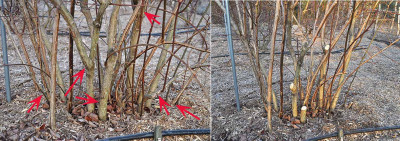
Blueberry bush, before & after pruning
The finished bush then — in theory — has about 4 six-year-old stems, 4 five-year-old stems, and so on, down to 4 one-year-old stems. By this time next year, each of those stems will have moved up a year in age. I’ll remove the 4 now seven-year-old stems and excess one-year-old stems, which are those that will have grown this season.
Oh, one more step: I go over each bush with my pruning shears, removing small or dead twigs and shortening stems that are out of bounds. With 16 bushes cramped into 900 square feet, “out of bounds” is pretty close.
Early Cukes, One the Way
As so often happens in late winter and early spring, and especially this year, weather is very variable. Today was sunny and, by winter standards, balmy — perfect for crawling in among the blueberry bushes to prune them. But no need to twiddle my thumbs on sunless days raw with cold. There are seeds to be sown.
Some people spend the first part of summer hankering to bite into their first ripe tomato. Even more than tomato, I eagerly await my first fresh cucumbers and peppers. Like tomatoes, both get a head start indoors.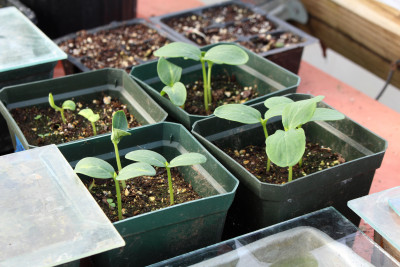
This year, after seeing the very early cucumber crop at Evolutionary Organics farm down the road from me, I thought I would give early cukes a try here at the farmden. On Kira, the farmer’s advice, I planted seeds a couple of weeks ago into potting soil in 4” plastic flower pots.
Cucumbers revel in heat, both for seed germination and for growing. So, after being watered, the seeded pots went onto the greenhouse’s electrically heated seed mat that’ll keep the seeds at a cozy 80°F. Seedlings are up, their roots still still in pots and still being warmed by the heating mat.
Within a couple of weeks, the cuke seedlings will start to outgrow their pots and need planting in the ground — not outdoors, though, but in the greenhouse. As I wrote, I’m hankering for a very early harvest. I’ll take the soil temperature which, I hope, will stay steadily above 65°F by then.
FLOWERS, ONE VERY, VERY SPECIAL
/3 Comments/in Design, Flowers, Fruit, Gardening/by Lee ReichMy Quest, Fulfilled
For thirty years, I’ve longed to catch at least a glimpse of Himalayan poppy (Meconopsis betonicifolia) in blossom; finally, yesterday, I achieved that goal. I wish I could say that I braved high seas to get to India, then traipsed across increasingly mountainous plains, and finally clawed my way up some jagged peak before coming face to face with the blossom. No, I was in Philadelphia, at the the Philadelphia Flower Show, when I remembered that nearby Longwood Gardens puts on a show of Himalayan poppies each year in early March. All that was needed was to brave traffic for the one hour drive (40 minutes without traffic) over to Longwood.
It was thirty years ago that expert plantsman and orchid hunter Norman Kellar told me of his admiring the blue poppy’s sky blue blossoms, both in reality and in reflection, from across a pond in England. The flowers, he said, are the purest blue of any flower. Did Longwood’s show meet up to my thirty year buildup? Yes. The petals, delicate as tissue paper, are a sky blue, the bluest I’ve seen in any flower. The center of each nodding blossom is lighted by a bottlebrush of orange stamens.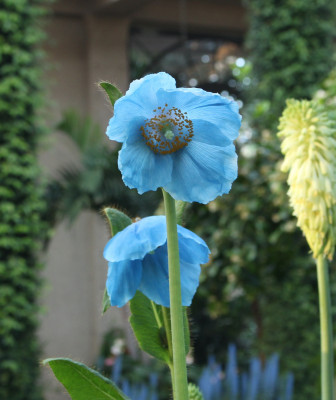
So why haven’t I, and why didn’t Norman, just plant Himalayan poppy to enjoy in our own backyards? The plant thrives — no, survives — only where summers remain cool. Above 70°F, the plant can’t photosynthesize, so it starves. I’ve tried growing blue poppy in the past. Each time it grew fine until July’s summer heat caused it to collapse, dead.
Longwood’s plants avoid heat by starting life in Alaska, where the plant thrives. Young plants are shipped in from Alaska in the fall and kept dormant in cold storage. Brought into Longwood’s cool (50-60°F) conservatory in January, they slowly awaken and, finally, blossom in March.
My plan is to sow seeds in potting soil in a seed flat in late summer, then water and chill the flat in a refrigerator for a few weeks. (Some seeds need that chilling to break their dormancy or speed germination. Whether or not blue poppy needs it, a few weeks of cool temperatures will do no harm.) By early fall, the seedlings should be up and growing, which they can do outdoors and then, if needed, in the greenhouse. When cold temperatures and low light slow the plants into dormancy, I’ll store the pots at a cool location in my basement.
Finally, in January, I’ll move the plants to a sunny window to begin growth. That time of year, even sunny windows don’t get too hot. Come March, with luck, a green thumb, and clicking my heels together three times, the sky blue blossoms will be staring at me — or out the window.
My first sighting of “our” bluebird was a week ago. Next year, looking at blue poppy plants blossoming at a window and bluebird outside the window would be a very nice prelude to spring.
Three Perennial Treats
Flowers have never been a focus of my gardens, and less so as each year goes by and I pay more attention to more enduring elements of my yard, such as fences, arbors, hedges, trees, and walls. Still, some flowers, such as the blue poppy, are worth the effort.
In years past, seed flat upon seed flat of all kinds of flowers would occupy growing space. This year: Just one flat of perennials, that one flat with four mini-furrows, one for dianthus, one for cardinal flower, one for foxglove, and one for purple coneflower. Each of those mini-furrows will yield enough seedlings, to be carefully separated then planted in individual cells of potting soil to grow into plants, for transplanting, for a nice show this summer and beyond.
The main attraction of the dianthus, for me, is its fragrance. From descriptions, the Riesen Giant Superb Mix Dianthus I just sowed seems very similar to the Dianthus caryophyllus that I grow in the greenhouse except, in contract to its greenhouse cousin, this dianthus is allegedly cold-hardy outdoors in Zone 5. (I have the feeling that both dianthus’s may be the same; the “giant” and “superb” in the name hooked me.)
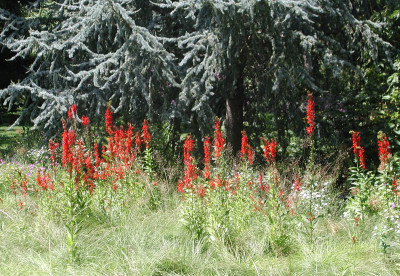
Cardinal flower
Cardinal flower is perennial, but not a long-lived one. It thrives in wet areas and, in congenial locations such as, I hope, here, will self-sow. This flower first caught my attention when its spike of fire engine red blossoms stared out at me from deep, deep shade. Deep shade is not home to many colorful flowers.
With spikes of pastel-colored blossoms, foxgloves have a charm evocative of blowsy cottage gardens. They also are only weakly perennial; but they self-sow readily. Their popping up willy-nilly around any garden from self-sown seeds adds to their blowsy effect.
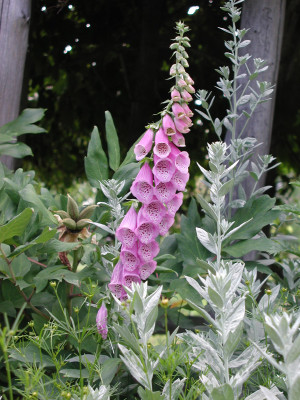
Foxglove
One downside to foxgloves is that flowers all line up only on one side of the flower spike, facing the sun. Except for the Excelsior series of foxgloves, which is what I have sown this year. It will be interesting to see how thoroughly the blossoms embrace the spikes and then how future years’ blossoms, from self-sown seedlings, display themselves, especially since they’ll be mating with run-of-the-mill foxgloves already growing here.
Nothing special about coneflowers. They’re native, easy to grow, and common. They’re also pretty.
Back to Fruit
Enough with the frills! Back to pruning kiwifruit and grape vines, blueberry, gooseberry, and currant bushes, and the plum, pawpaw, mulberry, a pear trees. They are pretty, too, and give me fruit.